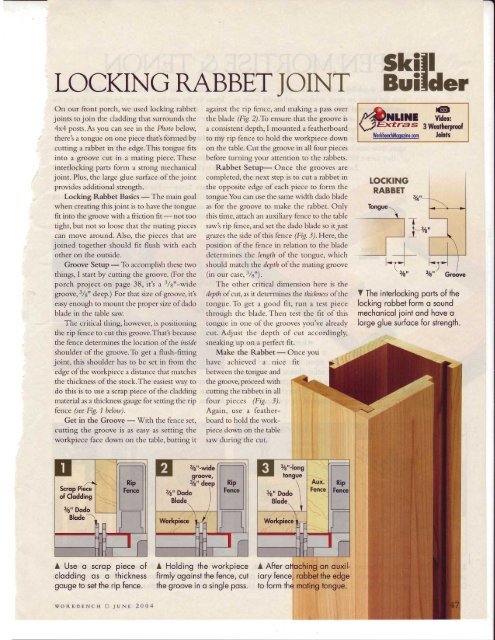You also want an ePaper? Increase the reach of your titles
YUMPU automatically turns print PDFs into web optimized ePapers that Google loves.
LOCKING RABBET JOINT<br />
On our front porch, we used locking rabbet<br />
joints to join the cladding that surrounds the<br />
4x4 posts. As you can see in the Photo below,<br />
there's a tongue on one piece that's formed by<br />
cutting a rabbet in the edge. This tongue fits<br />
into a groove cut in a mating piece. These<br />
interlocking parts form a strong mechanical<br />
joint. Plus, the large glue suface of the joint<br />
provides additional strength.<br />
Locking Rabbet Basics -<br />
The main goal<br />
when creating this joint is to have the tongue<br />
fit into the groove with a friction fit - not too<br />
tight, but not so loose that the mating pieces<br />
can move around. Also, the pieces that are<br />
joined together should fit flush with each<br />
other on the outside.<br />
Groove Setup - To accomplish these rwo<br />
things, I start by cutting the groove. (For the<br />
porch project on page 38. it's a l/a"-wide<br />
groove,3/s" deep.) For that size ofgroove, it's<br />
easy enough to mount the proper size of dado<br />
blade in the table saw<br />
The critical thing, however, is positioning<br />
the rip fence to cut this groove.That's because<br />
the fence determines the location of the inside<br />
shoulder ofthe groove.To get a flush-fitting<br />
joint, this shoulder has to be set in from the<br />
edge of the workpiece a distance that matches<br />
the thickness of the stock.The easiest way to<br />
do this is to use a scrap piece of the cladding<br />
material as a thickness gauge for setting the rip<br />
fence (see Fig. 1 below).<br />
Get in the Groove -<br />
With the Gnce set,<br />
cutting the groove is as easy as setting the<br />
workpiece face down on the table, butting it<br />
against the rip fence, and making a pass over<br />
the blade (Fig 2) 'lo ensure that the groove is<br />
a consistent depth, I mounted a featherboard<br />
to my rip fence to hold the workpiece down<br />
on the table. Cut the groove in all four pieces<br />
before turning your attention to the rabbets.<br />
Rabbet Setup-<br />
Once the grooves are<br />
completed, the next step is to cut a rabbet in<br />
the opposite edge ofeach piece to form the<br />
-trF-<br />
tongue.You can use the same width dado blade<br />
as for the groove to make the rabbet. Only<br />
this time, attach an auxiliary fence to the table<br />
saw's rip fence, and set the dado blade so it just<br />
grazes the side of this fence (Fig.,f. Here, the<br />
position of the fence in relation to the blade<br />
determines the length of the tongue, which<br />
should match the depth of the mating groove<br />
(in our case,3/g").<br />
The other critical dimension here is the<br />
depth of cut,as it determines the thickness of the<br />
tongue. To get a good fit, run a test piece<br />
through the blade. Then test the fit of this<br />
tongue in one of the grooves you've already<br />
cut. Adjust the depth of cut accordingly,<br />
sneaking up on a perfect fit.<br />
Make the Rabbet - Once you<br />
have achieved a nice fit<br />
between the tongue and<br />
the groove, proceed with !<br />
cutting the rabbets in all<br />
four pieces (Fig. 3)<br />
Again, use a feather- i<br />
board to hold the workpiece<br />
down on thLe<br />
table<br />
saw during the cr ut.<br />
skill Builder<br />
!@<br />
Weo:<br />
) E>












![Til]tl](https://img.yumpu.com/45878240/1/190x245/tiltl.jpg?quality=85)




